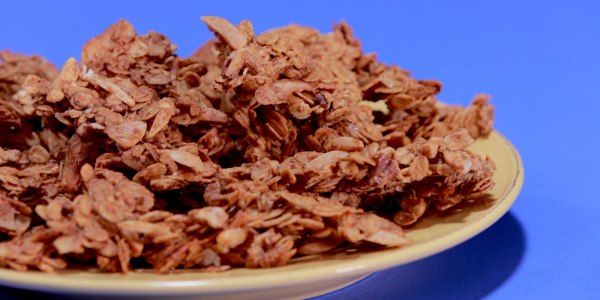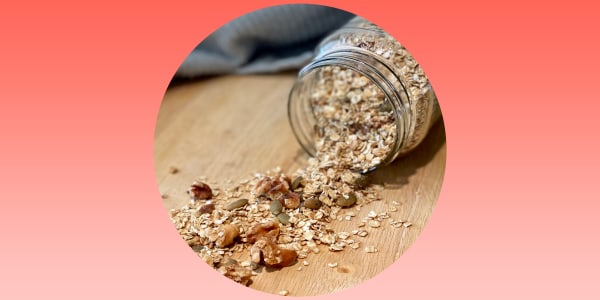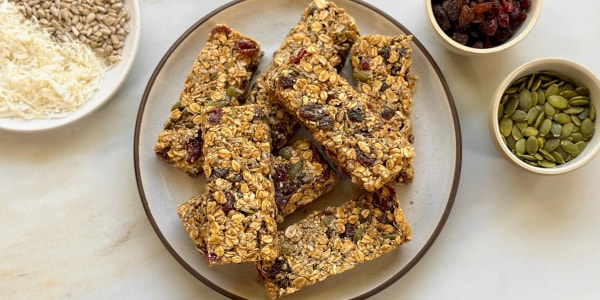Granola can be a crunchy, sweet and satisfying start to your day, midday snack or even a nighttime treat. But, if you're not choosing the healthiest granola, it can also pack hidden added sugar and calories in a surprisingly tiny serving size, dietitians warn.
Granola, like trail mix, gained popularity originally as a "great grab-and-go backpack snack for hiking, biking or just being out and about during the day," Julia Zumpano, registered dietitian with Cleveland Clinic’s Center for Human Nutrition, tells TODAY.com.
Whether you prefer it as a topping, in a bar or as a snack on its own, granola is a great food that can be crunchy, slightly sweet and can have some nutrients in it, she explains.
"Granola can be a great source of fiber, protein and healthy fats, which predominantly come from the rolled oats, nuts and seeds," Rachel Stahl Salzman, registered dietitian and certified diabetes care and education specialist at Weill Cornell Medicine, tells TODAY.com.
It can also contain a lot of vitamins and minerals, she adds, especially iron and B vitamins.
However, some types of granola contain a surprisingly large amount of added sugar and calories for a relatively small serving size, the experts warn. Here's what they want you to look for when choosing a healthy granola.
What makes granola healthy?
High in gut-healthy fiber
The major benefit of whole-grain granola is that it will provide fiber, which keeps your gut functioning properly and helps you feel full.
For many granolas, that fiber is from rolled oats. "The oats have a lot of fiber that can be helpful for digestive health, lowering cholesterol and weight management," Stahl Salzman says.
Others may contain a variety of healthy whole grains, like buckwheat, amaranth and quinoa. Grain-free granolas can also provide fiber from ingredients like chickpea flour or almond flour, Zumpano says. Seeds, such as chia seeds or pumpkin seeds, can add even more healthy fiber.
When choosing a granola, Zumpano and Stahl Salzman recommend looking for at least 3 to 5 grams of fiber per serving.
A good amount of filling protein
Granola is not likely to be a major source of protein in your diet, but some varieties can give you a helpful boost. In particular, granola that contains seeds, nuts and nut butters will contribute at least a few grams of protein to your day, Zumpano explains.
A healthy granola should contain at least 5 grams of protein, Stahl Salzman says, and ideally closer to 7 grams. Zumpano agrees, but adds that 7 grams "may be ambitious for some granolas."
Sprinkle that on a healthy Greek or Icelandic yogurt and your breakfast can easily top 20 grams of filling, energizing protein.
Healthy fats
You want to look at "how much fat is being added and what kind of fat," Zumpano says.
Stahl Salzman agrees: "We know that a lot of granola could be high in healthy fats predominately from nuts and seeds," she says. "But, depending on what kind of oil might be used, we just want to be mindful of saturated fat," she adds.
In general, you want "to stick to more plant-based fats like nuts or nut butters versus hydrogenated oil or processed vegetable oils," Zumpano says. In particular, Stahl Salzman recommends opting for granolas containing olive oil or avocado oil over those containing palm oil or coconut oil.
Minimal added sugar
"Some granola can also pack a lot of added sugar, which would make it a less healthy choice," Stahl Salzman says.
Nearly all granola contains at least a bit of added sugar, Zumpano says. And granolas marketed with sweet flavorings (like vanilla or chocolate) and dried fruit tend to have even more added sugar.
Both dietitians recommend capping added sugar in granola at 5 grams, but less is always better.
“I like to use like spices like cinnamon, which could be a great way to add more of a sweet flavor without the added sugar,” Stahl Salzman says.
Reasonable serving size
Granola can be quite calorically dense and there's no standard serving size, Zumpano says. Serving sizes for granola can "range from 2 tablespoons to a half a cup, so it can be drastically different," she says.
So take a look at the serving size and calories on the label before pouring yourself a bowl. And consider saving higher-calorie granolas for toppings, like sprinkling them on yogurt, chia seed pudding, a baked apple or smoothie, the experts say.
Think of calorically dense granola "not necessarily as a meal in itself, but more like a condiment," she explains.
A good granola "adds a lot of texture and flavor without needing to go overboard," Stahl Salzman says, noting that some granolas now come in single-serving packets to make portion control a little easier.
What's the healthiest granola you can buy?
Granolas that contain good amounts of fiber and protein while being low in added sugar — all within a realistic portion size — are going to be the healthiest choices.
In general, that means you'll want to look for granolas that are heavier on nuts, seeds, whole grains and nut butters while avoiding or minimizing sugary flavorings and add-ins, like chocolate chips.
"Look for simple ingredients that you can understand and pronounce," Stahl Salzman says. Ingredients that aren't immediately understandable could be fillers or added protein concentrates, which are "things you don't really want to have," she says.
When Consumer Reports evaluated the protein, fat, fiber, added sugar and calories per serving in 38 granolas, these seven options emerged as the healthiest choices:
- Back Roads, Ancient Grains (unsweetened)
- Bear Naked Granola, Fruit & Nut
- Bob’s Red Mill Honey Almond Granola
- Kind Healthy Grain Clusters, Raspberry With Chia Seeds
- Nature’s Path Honey Almond Granola
- Purely Elizabeth Original Granola
- Wildway Grain-Free Granola, Banana Nut
Try making your own granola
If you're not satisfied with store-bought options, you can always make your own granola at home.
While it's certainly more time consuming than simply buying a bag, making your own granola in batches is often more cost-effective and gives you the freedom to use exactly the ingredients you prefer, Zumpano explains. "Also, you could cater it to specific dietary restrictions," Stahl Salzman adds.
Feel free to substitute different ingredients to your specific tastes or requirements, like swapping in sunflower seeds for pumpkin seeds or cashews for almonds.
Plus, the recipes tend to be on the simpler side. "It's pretty easy," Zumpano says. "Most of the time, you can't mess it up unless you burn it."


